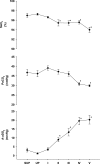Intra-pulmonary shunt and pulmonary gas exchange during exercise in humans
- PMID: 15388775
- PMCID: PMC1665323
- DOI: 10.1113/jphysiol.2004.069302
Intra-pulmonary shunt and pulmonary gas exchange during exercise in humans
Abstract
In young, healthy people the alveolar-arterial P(O(2)) difference (A-aDO(2)) is small at rest, but frequently increases during exercise. Previously, investigators have focused on ventilation/perfusion mismatch and diffusion abnormalities to explain the impairment in gas exchange, as significant physiological intra-pulmonary shunt has not been found. The aim of this study was to use a non-gas exchange method to determine if anatomical intra-pulmonary (I-P) shunts develop during exercise, and, if so, whether there is a relationship between shunt and increased A-aDO(2). Healthy male participants performed graded upright cycling to 90% while pulmonary arterial (PAP) and pulmonary artery wedge pressures were measured. Blood samples were obtained from the radial artery, cardiac output was calculated by the direct Fick method and I-P shunt was determined by administering agitated saline during continuous 2-D echocardiography. A-aDO(2) progressively increased with exercise and was related to (r = 0.86) and PAP (r = 0.75). No evidence of I-P shunt was found at rest in the upright position; however, 7 of 8 subjects developed I-P shunts during exercise. In these subjects, point bi-serial correlations indicated that I-P shunts were related to the increased A-aDO(2) (r = 0.68), (r = 0.76) and PAP (r = 0.73). During exercise, intra-pulmonary shunt always occurred when A-aDO(2) exceeded 12 mmHg and was greater than 24 l min(-1). These results indicate that anatomical I-P shunts develop during exercise and we suggest that shunt recruitment may contribute to the widened A-aDO(2) during exercise.
Figures





References
-
- Berk JL, Hagen JF, Tong RK, Maly G. The use of dopamine to correct the reduced cardiac output resulting from positive end-expiratory pressure. A two-edged sword. Crit Care Med. 1977;5:269–271. - PubMed
-
- Bishop MJ, Cheney FW. Effects of pulmonary blood flow and mixed venous O2 tension on gas exchange in dogs. Anesthesiology. 1983;58:130–135. - PubMed
-
- Butler BD, Hills BA. The lung as a filter for microbubbles. J Appl Physiol. 1979;47:537–543. - PubMed
-
- Cheney FW, Pavlin J, Ferens J, Allen D. Effect of pulmonary microembolism on arteriovenous shunt flow. J Thorac Cardiovasc Surg. 1978;76:473–478. - PubMed
-
- Conhaim RL, Staub NC. Reflection spectrophotometric measurement of O2 uptake in pulmonary arterioles of cats. J Appl Physiol. 1980;48:848–856. - PubMed
Publication types
MeSH terms
Substances
LinkOut - more resources
Full Text Sources
Other Literature Sources
Medical
Research Materials
Miscellaneous

